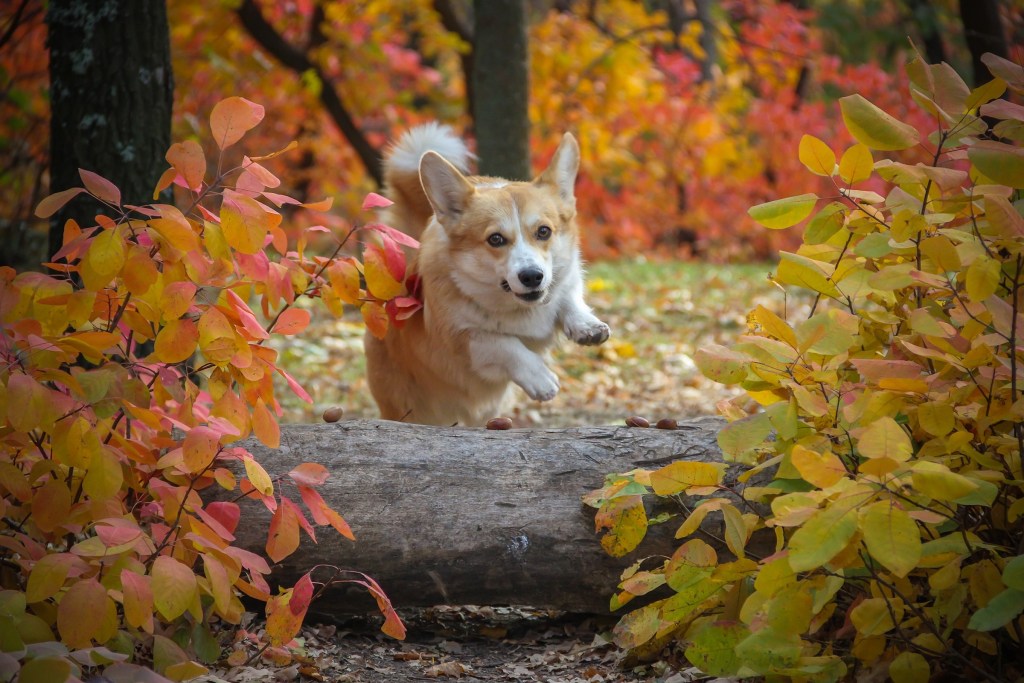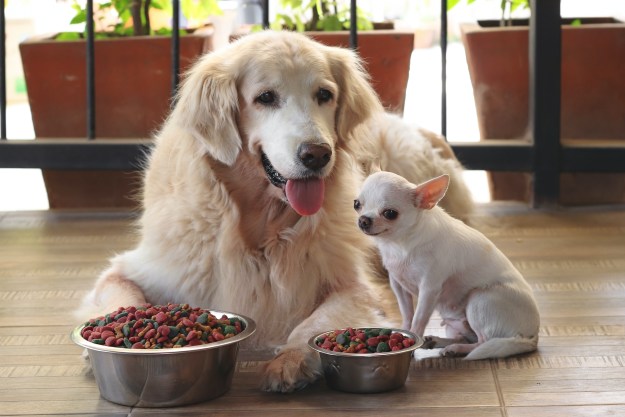Whether you simply admire the golden warmth of autumn or you’d rather go all out this fall, you can help both yourself and your dog ring in the season by putting together some delicious homemade dog treats. They’re fun, easy, and (most importantly) healthy for your precious pup.
These fall dog treats take advantage of festive foods — like turkey and pumpkin — that everyone in the family enjoys. Who knows, they may even inspire you to whip up an autumnal feast of your own. With October’s freshest ingredients ready to go, though, your pup is truly in for a treat — no tricks here! These are a few of our favorite fall-time snacks for dogs:

Dried-pumpkin dog jerky
This recipe is so easy that it doesn’t even require instructions! All you need is a pumpkin, a knife, an oven or food dehydrator, and a lined baking sheet. You’ll start by cutting your pumpkin into small slices or nuggets, though it’s important to remember that the thickness of each piece is directly related to how long you’ll need to cook it.
Whether you leave the skin on is up to you — it’s not harmful — but it doesn’t provide any real nutrition and often isn’t digested at all. The same goes for the seeds; it’s not a bad thing if your dog gets one, but it’s not without its risks. Any harder-to-digest material can cause intestinal blockages in rare cases. You should not coat or season the pumpkin in anything before drying, as you can risk getting your dog sick from spices or oils.
When dehydrating pumpkins, use a lower temperature for a longer amount of time: 250 degrees is an ideal setting for drying food, though you can play around with time and temperature to find the perfect match for you. In the end, you’ll get a delicious, chewy treat for your dog to occupy herself with, and now you’ll know what to do with any extra pumpkin you may acquire. It’s a win-win!
Turkey-and-cranberry dog cookies
Turkey and cranberries are two in-season ingredients that make the perfect flavor combination — even for dogs. Although they’re just as savory as they are sweet, these cookies from Dog Tipper are a great way to include your pup when it’s time to gather for a cozy autumn meal. Here’s how to make them:
Before beginning, heat your oven to 375 degrees, grease 2 cookie sheets, and grab your ingredients:
- 1 cup turkey
- 1 egg
- ½ cup water or broth (as needed)
- 1 cup cranberries
- 3½ cups whole wheat flour
- 1 tablespoon baking powder
You can use either prepared plain turkey or frozen, previously cooked ground meat for this recipe; start by blending it in a food processor or blender with the egg, adding water or broth to reach a baby food–like consistency. Next, add the cranberries, blend again, and stir in the dry ingredients until you get a dough.
Now the fun part: Roll out your dough and use cookie cutters of your choice to make cute shapes for your pup. When in doubt, think seasonal; you can never go wrong with a pumpkin-imitating treat!
Once your cookies are ready to go, bake them for 25 minutes. They can last in the refrigerator — once cooled, of course — for up to 3 days, but you can keep them in the freezer for up to 6 months if you need to.

Pumpkin-oatmeal spice dog treats
While you’re sipping a pumpkin-spice latte, your dog can be enjoying an autumnal treat of her very own. PetGuide’s pumpkin-oatmeal spice biscuits are delicious, festive, and healthy, too: Oatmeal and pumpkin are both great helpers for canine digestion.
To bake these yummy treats, you’ll need:
- ½ cup canned pumpkin (no artificial/added sugars, please)
- ½ cup water
- 2 tablespoons olive oil
- ½ teaspoon cinnamon (don’t substitute other spices, as many are not dog safe)
- ½ cup oatmeal
- 2½ cups whole wheat flour
Once you have everything, heat your oven to 375 degrees. In a mixing bowl, stir your wet ingredients — pumpkin, water, and oil — into an even texture, then slowly stir in your dry ingredients. Everything should be fully mixed and evenly blended.
When your dough is ready, roll it out on a floured cutting board or countertop until it’s about ¼ inch thick. Then, it’s cookie cutter time! You know the drill. Bake your treats on a lightly greased cookie sheet for 30–40 minutes and enjoy the lovely smells while you wait.
Now that cozy season is finally here, we can all relax with some comfy sweaters and mouthwatering snacks — dogs included! Your pup will surely appreciate the time and effort you put into her homemade treats, and you can feel good knowing that your best furry friend is getting only the freshest, highest-quality food. What’s not to love?
Editors' Recommendations
- 5 surefire ways to keep your dog off your bed and get a good night’s sleep
- Are ‘dog years’ really 7 human years? How to calculate your dog’s age
- How to tell if your older dog’s health decline means the end is near
- Xylitol is dangerous for dogs: 10 surprising products that contain it as a hidden ingredient
- Funny dog video: Pup has an adorable reaction to a superhero pet on TV




